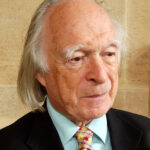The conference is organized around the following six themes, spanning the three conference days:
Biological Relativity and the Biomedical Sciences
Natural Genetic Engineering, Biogenesis, and Reticulate Evolution
Epigenetics and Directed Evolution of Complex Systems
Paradigms and Narratives of Evolution
Cognition, Teleonomy, Agency, and Consciousness
Learning and Intelligence Across and Beyond Life
Wednesday January the 7th, 2026
THEME: Biological Relativity and the Biomedical Sciences
9h15

Denis Noble (Onsite)
Biological Relativity and its Implementation in Theories of Evolution
The Principle of Biological Relativity states simply that there is no privileged level of causation in living systems. Rather, there are multiple levels of organisation. We can be sure of that because no solutions to the equations of motion in any system can be solved without knowledge of the boundary conditions. Cells alone form many of those boundary conditions, independent of genomes. So do tissues, organs, and systems of the body. The Principle of Biological Relativity is therefore a logical necessity. The lecture will outline what this must mean for any theory of evolution and why neither neo-Darwinism nor the Modern Synthesis can satisfy those conditions. Those latter theories require (1) That DNA can replicate faithfully like a crystal; (2) That the germline is isolated from the rest of the organism by the Weismann Barrier; (3) That association scores between genes and functionality represent what we can know about causality; and (4) That the Central Dogma of Molecular Biology prevents organisms from editing their genomes. All four of these assumptions are incorrect in ways that invalidate a gene-centric interpretation of evolutionary biology. Organisms are necessarily open systems. Inheritance cannot, therefore, be restricted solely to what is passed down the generations through the genome. That is what opens up many opportunities for future work in evolutionary biology.
Denis Noble is a Physiologist, Systems Biologist, and Philosopher of Evolutionary Biology. His experimental research has focused on the heart. He was responsible for developing the first mathematical models of pacemaker activity, and he also demonstrated that pacemaker processes are formed within multiple interlocking physiological control networks. Individual processes dependent on just one causal gene can therefore replace each other when the protein involved is blocked or its gene knocked out. After retiring from the Chair of Cardiovascular Physiology at Oxford, Noble started working on Evolutionary Biology. He has now published more than 50 books and articles in this field. He is currently the Director of Computational Physiology in the Department of Physiology, Anatomy & Genetics at Oxford and a chairholder at Daegu-Gyeongbuk Institute of Science and Technology, South Korea. He is a Fellow of the Royal Society and a Foreign Member of several other National Academies, as well as the holder of Honorary Doctorates from several universities in the United Kingdom and abroad. His work on the heart won the Lomonosov Grand Gold Medal of the Russian Academy of Sciences in 2022.
10.30am Break
11hr00 - 13hr00
![]()
![]()
 Benedikt Hallgrímsson (Onsite)
Benedikt Hallgrímsson (Onsite)
The Polygenic Basis for Mendelian Disease and the Attribution of Cause
Are mutations satisfactory causes of phenotypes or even of differences in phenotypes? This question, with roots in the origins of genetics, revolves around where we separate the relevant from the extraneous in explanations of heritable variation. Genetic diseases associated with specific mutations are routinely attributed to the influence of those mutations on biological systems. Analyses of the genetics of human Mendelian diseases, however, is revealing a more nuanced picture. Many such diseases are associated with effects on complex phenotypic features, including the face. These effects are often similar to the directions of variation present in the background population of individuals who do not have these diseases. The facial shape effects associated with achondroplasia, for example, map to an axis of coordinated variation that is present in the background population and associated with variation in growth at the cartilaginous growth centers of the skull. This axis has a polygenic basis enriched for genes related to cartilage development. Remarkably, the conjoint phenotypic effects of the genes associated with this axis replicate the achondroplasia phenotype without the “causative” Fgfr3 gene, in both mice and humans. Finally, relatives of people with genetic diseases tend to score higher than expected on the disease axis of their proband relative. These findings suggest that the directions of variation associated with genetic diseases often exist independently of causative mutations, which places the explanatory burden on disease-related phenotypes more on the propensities of biological systems to respond to perturbation rather than on the mutations themselves. I explore this issue in terms of what it means to individuate genes as causes of disease, its implications for the developmental genetics of disease, and also in terms of the blurred distinction between discontinuous and continuous variation.
Benedikt Hallgrímsson is Professor and Head of the Department of Cell Biology & Anatomy at the University of Calgary. The central motivating question for his research program is how genetic and environmental influences act on developmental systems to produce anatomical variation. His program uniquely integrates advanced imaging and measurement (morphometrics) with developmental biology to understand the underlying mechanisms for phenotypic variation. His work extends to the mechanisms that underlie structural birth defects, such as craniofacial anomalies, as well as the anatomical aspects of genetic diseases and variation more generally, including differences among individuals in height or facial shape. He is currently the Deputy Director of the Alberta Children's Hospital Research Institutes, and he co-leads the Canada First Research Excellence Program "One Child Every Child," which aims to improve outcomes for child health in Canada. Benedikt Hallgrímsson is a Fellow of the American Association for the Advancement of Science (2018) as well as the Canadian Academy of Health Sciences (2019) and is a winner of the Rohlf Medal for Excellence in Morphometrics (2015). Recent biomedical publications include papers on the development of the face and the craniofacial shape; achondroplasia-like facial variation; and how three-dimensional facial imaging assists in syndrome diagnosis. Evolutionary developmental papers include works on evolvability; phenotypic covariation; and how developmental nonlinearity drives phenotypic robustness.
 Azra Raza (Online)
Azra Raza (Online)
The Unpredictable Trajectory of Clonal Evolution in Cancer and the Imperative of Early Detection
Despite the common origin of many cancers in a single aberrant cell—the first cell—the downstream trajectory of malignant progression is profoundly individual. Following this initial event, each tumour undergoes clonal evolution shaped by a host of factors: genetic background, immune surveillance, microenvironmental pressures, metabolic states, and therapeutic exposures. These forces interact in non-linear, often chaotic ways, producing unique evolutionary paths for each patient. No two cancers are alike, even if they originate from the same tissue, carry the same mutation, or are diagnosed at the same stage. In this context, the same clonal architecture that leads to indolence in one individual may result in explosive growth in another. This unpredictability parallels the framework of emergent complexity described by Stephen Wolfram. In his work on cellular automata, Wolfram demonstrated that even simple rules applied to uniform starting conditions can produce wildly divergent and irreducibly complex outcomes. Cancer behaves analogously. As such, predicting the future behaviour of a tumor based on its founding mutation is inherently limited, regardless of how sophisticated our molecular profiling tools become. While tailoring treatment to the individual tumour's molecular characteristics is conceptually appealing, the staggering complexity and plasticity of cancer evolution make this approach biologically uncertain and economically unsustainable at the population level. Given these realities, the most rational and humane strategy is to intervene at the earliest stages of clonal evolution, when tumours are still biologically simple, genetically stable, and clinically silent. Early detection—catching the first cell or its earliest clonal progeny—offers the only opportunity to shift the balance decisively in favour of a cure. It is here, before the chaos of complexity unfolds, that cancer can still be a manageable disease.
Azra Raza, MD, is the Chan Soon-Shiong Professor of Medicine and Director of the Edward P. Evans Foundation MDS Centre at Columbia University, USA. A practicing oncologist, she sees 30-40 cancer patients weekly and also directs a cancer research lab. The recipient of three serially endowed chairs and an honorary PhD, Raza has collected over 60,000 longitudinally drawn blood and marrow samples from thousands of her patients with preleukemia and acute myeloid leukaemia. She met with President Biden to plan the Cancer Moonshot and with President Bill Clinton for a 3-day Breakthroughs in Science and Technology Retreat. Describing her groundbreaking ideas in the highly acclaimed, bestselling book, The First Cell and the Human Costs of Pursuing Cancer to the Last, Raza is devoted to shifting the healthcare focus from treatment to early detection and prevention. Raza is the Founder and Director of the Scientific Advisory Board of The First Cell Therapeutics Inc (TFCTx). Raza is the owner of thousands of books in Urdu and English, and co-authored GHALIB: Epistemologies of Elegancen, a book dedicated to the translation and interpretation of poetry. She also runs a YouTube channel which displays about 100 videos on subjects ranging from cancer to poetry. Some recent publications include papers on polyploid giant cells in Leukaemia; giant cells associated with myelodysplastic syndromes. An accessible convocational address on her cancer research is available here.
 Laura Weyrich (Online)
Laura Weyrich (Online)
The role of the microbiome in health and disease: insights from ancient DNA studies
Interpreting the evolutionary history of microbial communities within the human body (microbiota) is key to understanding how numerous diseases originate in modern humans. DNA sequencing of preserved dental plaque (calculus) from ancient hominin skeletons now provides a unique opportunity to examine the evolution of microbiota and disease through time. We employed a shotgun sequencing approach to obtain ancient microbial DNA from the dental calculus of European Neandertals and ancient humans from Europe, South America, Asia, and Africa, aiming to reconstruct how these diverse microbial communities have adapted to shifts in lifestyle, diet, and environment over the past 40,000 years and influenced human health. We identified significant shifts in the oral microbiota during the adoption of farming, the Industrial Revolution, and more recently, during the Great Acceleration, revealing how microbial communities respond to changes in diet and environment worldwide. For example, we observe significant shifts in microbiota associated with meat, carbohydrate (sugar), and milk consumption over time in different environments, revealing the loss and replacement of certain microbial species and communities within the mouth. Together, these data provide the first record of human microbiota evolution in real-time and a means to understand why certain bacterial communities are now associated with disease in the modern world. This research also enables us to think broadly about the applications of this work in developing new therapies that prevent dental decay and periodontal disease in the future.
Dr. Weyrich is a Microbiologist, Anthropologist, and Ethicist who uses evolutionary theories to develop novel health therapeutics. She is an Associate Professor of Anthropology and Bioethics at Pennsylvania State University and is the Director of the Penn State Ancient Biomolecules Research Environment. She also holds an adjunct appointment in the School of Biological Sciences at the University of Adelaide. She led the first team to reconstruct the Neandertal oral microbiome, and she is also the CEO and Founder of Microversal LLC, a company developing Oral Microbiome Transplants – leveraging health histories from the past to improve our health tomorrow.
13hr00 Lunch
THEME: Natural Genetic Engineering, Biogenesis, and Reticulate Evolution
14h30
 James A. Shapiro (Onsite)
James A. Shapiro (Onsite)
How Life Changes Itself in Evolution Organically
Conventional neo-Darwinian theory does not account for the numerous ways in which living cells can alter their genomes. For example, plasmid-based horizontal transfer and integron structures that accumulate coding sequences have enabled the evolution of multiple resistant superbugs in under 20 years. Horizontal transfers occur across virtually all taxonomic boundaries to provide one-step acquisitions of complex adaptive functions. Symbiogenetic cell fusions involving massive endosymbiont-to-nucleus transfers of coding sequences were essential in the evolution of eukaryotes and photosynthetic eukaryotes. Many proteins have evolved novel functions through domain shuffling, facilitated by exon rearrangements. Repetitive transposable elements formatted chromosomes for accurate genome replication (centromeres and telomeres) and organised complex adaptations by mobilizing control sequences to dispersed coordinately regulated loci. One genetic locus can encode multiple adaptive products via alternative splicing and production of bioactive ncRNAs. There is no junk DNA. Genome change is responsive to stress conditions, which activate transposable elements. Of particular importance is interspecific hybridization that often results from the failure to find a conspecific mate. Interspecific hybridization is the most reliable method for generating new taxa, such as the potato. As we learned in 2011, first in cancer cells and then in human and other germlines, chromosome breakage and other traumas can induce episodes of chromosome-wide or genome-wide DNA rearrangements. During the process of repairing chromosome breakage, some repair functions involve DNA polymerases that jump templates to combine sequences from multiple sites in the genome, or even produce completely untemplated DNA. There seems to be no limit on how living cells can rewrite their genomes.
James A. Shapiro is Professor of Microbiology Emeritus in The Department Of Biochemistry And Molecular Biology at the University Of Chicago. He received his Ph.D. in Genetics from Cambridge University in 1968 under Prof. W. Hayes, FRS. At the University of Chicago since 1973, he was the Darwin Prize Visiting Professor at the University of Edinburgh (1993). In 2001, he received an O.B.E. for services to the Marshall Scholarship Program. He is a founder of the Third Way of Evolution, which aims to raise awareness of scientific alternatives to Intelligent Design and Neo-Darwinism. His pioneering books are on mobile genetic elements, natural genetic engineering, and bacterial multicellularity. His complete CV can be found here.
15hr45 break
16hr15 - 18hr15
 Joana C. Xavier (Onsite)
Joana C. Xavier (Onsite)
Causality at the Root: Metabolism, Cooperation, and the Making of Life
Dominant narratives in biology raised the gene to become the privileged agent of causality not only in evolution, but in life itself. Yet, no living system known to maintain itself or replicate does so without a membrane, proteins, and cofactors supporting its genome. Here I argue that contemporary origins of life research exposes deep fractures in Modern Synthesis, a stark position in Philosophy of Biology passing as science wearing reductionist garments. I will show that data-based, engineering-informed origins science reveals the essential cooperation of multiple cellular components. If simplistic paradigms remain appealing and easier to communicate widely, modern Biology demands Noble's relativity, Kauffman's complexity, and Fox Keller's attention to the power of metaphor. My work backs up the preceding arguments through (1) The reconstruction of ancient autocatalytic cores of metabolism, which can exhibit cooperation and adaptation in particular geochemical contexts independently of genetic replication; and (2) Exposing the vital role of cofactors in establishing and coordinating those networks, all the way to modern prokaryotes and us. Metabolic networks, old and new, challenge reductionist assumptions about individuality, inheritance, and selection. They suggest instead a relational view where structure and function co-emerge from environmental constraints. Their origin and evolution depended not only on mutational variation but primarily on collective dynamics and deep environmental coupling. Processes such as constraint-based emergence and energy transfer are not background conditions, but co-constitutive with the evolution and unfolding of biological function. These findings extend current evolutionary paradigms by foregrounding systemic and multilevel causation, offering an empirically grounded and computationally formalizable path beyond the gene-to-trait paradigm. They also call for a revision of intra- and interdisciplinary boundaries, as well as a reestablishment of the boundaries between science and philosophy. Origins research emerges as the ultimate foundation for the Biology of the 21st century: understanding how life's components persist in intricate connections begins at the root.
Joana C. Xavier is a Bioengineer, Computational Biologist, Philosopher of Science, and Entrepreneur whose research explores the origins of life, agency and feelings, with a focus on metabolism, autocatalysis, and the relational dynamics of evolution. Her work bridges prebiotic chemistry, computational biology, and advanced bioengineering with philosophical approaches to causation in living systems. Xavier has held research positions at Imperial College London, University College London, EMBL, and the University of Düsseldorf. She has received research support from the Portuguese Foundation for Science and Technology (FCT), Argonne National Laboratory, and EMBL, and was awarded a prestigious UKRI Future Leaders Fellowship, which she declined. She is a co-founder and former executive board member of the Origins of Life Early-career Network (OoLEN), where she helped shape interdisciplinary collaboration across the field. Her recent publications include papers on autocatalytic networks and reaction networks; Wilhelm Ostwald; and the origin of life. She is currently pursuing independent research and entrepreneurship, integrating computational modelling with modern bioengineering and philosophical analysis — from prokaryotes, to dogs, to us.
 Marilyn J. Roossinck (Onsite)
Marilyn J. Roossinck (Onsite)
Viruses, Fungi, and Plants: Intimate Relationships
Since plants made the transition from sea to land some 470 million years ago, they have relied on fungi for survival. Plant-fungal symbioses have strongly impacted the evolution of both individuals in the holobiont. Evolutionary studies of land plants often overlook the role of fungi in plant adaptation to their terrestrial environment. The role of viruses in these relationships, where viruses have been essential yet unknown actors, has been largely overlooked. With the extreme plasticity of their genomes, viruses can serve as a means for rapid adaptation to changing environments, providing essential traits for survival. Viruses are also involved in fungal-animal relationships, where they can impact a fungus's ability to colonize an animal. I will present data from field and laboratory studies that demonstrate the critical role of fungal viruses in plant adaptations to extreme environments and in the colonization and invasion of animals.
Marilyn Roossinck is an Emeritus Professor of Virus Ecology from Penn State University. She spent four decades studying the relationships and evolution of plant and fungal viruses at Cornell University, The Noble Foundation, and Penn State's Centre for Infectious Disease Dynamics. She is currently an Associate Editor for the journal Virus Evolution, and is a writer of accessible science books such as Virus, An illustrated Guide to 101 Incredible Microbes; and Viruses, A Natural History. Recent scholarly publications include papers on virus-free and wild-type isolates of Pseudogymnoascus destructans; The role of Pseudogymnoascus destructans partitivirus-pa in the spread of white-nose syndrome; The Impact of cultivated hosts on the recombination of Cucumber mosaic virus; and the Manipulation of aphid behaviour by a persistent plant virus.
Predrag Slijepcevic (Onsite)
 Biocivilisations: A New Look at the Science of Life
Biocivilisations: A New Look at the Science of Life
When evolution is examined through the lenses of agent theory and systems biology, the focus shifts from a mechanical and deterministic view, where organisms are seen as passive automata shaped by selfish genes and inflexible environments, to a dynamic and indeterministic perspective. In this view, organisms are recognized as biological agents whose cognitive activities shape the living systems of our planet. The actions of these biological agents, particularly their ability to learn, drive the ever-changing structure of the biosphere, constantly expanding its phase space. This new perspective challenges the anthropocentrism often found in the life sciences, which tends to interpret cognition as a trait unique to humans. Instead, cognition is seen as a biological universal. The accomplishments of civilisation – ranging from communication and engineering to science and medicine – are typically framed by modern science as products of human culture alone. However, these achievements exist within societies formed by all biological agents, representing a long evolutionary continuum of biocivilisations, from bacteria to humans. Moreover, the anthropocentric view of human culture becomes untenable when we consider the context of biocivilisations. Culture is a phenomenon that spans the entire biosphere, arising from the learning capacities of various agents and their societies. Ultimately, this revised perspective leads to a vision of life as a biocivilising force, wherein culture transcends its anthropocentric meaning and assumes broader significance across the biosphere. It also challenges the standard evolutionary narrative, which suggests that evolutionary changes are mainly driven by genetic mutations or shifts in gene frequencies. Instead, these changes are influenced by the cognitive actions of agents, particularly their capacity to learn.
Predrag Slijepcevic is a Biologist with a keen interest in chromosome structure and organization, the evolution of life, and the philosophy of science. He is an expert in cell biology, molecular cytogenetics, and the emerging field of cell-based cognition. Throughout his career, Predrag has worked at Cambridge, St. Andrews, and Leiden Universities. He is currently a lecturer and Researcher at Brunel University of London. His book, Biocivilisations: A New Look at the Science of Life , has won the prestigious Nautilus Book Award for 2024 with a gold medal in the Restorative Earth Practices category. The German edition of the book will be published in 2026. Predrag is currently involved in a project titled Cognition-Based Biology: Sentience, Communication, and Symbiosis, collaborating with William B. Miller Jr., František Baluška, and Arthur S. Reber.
 Blaise Agüera y Arcas (Onsite)
Blaise Agüera y Arcas (Onsite)
A Cooperative, Computational Theory of Evolution
In the 20th century, evolution was assumed to be driven by random mutation and selection for fitness. In more recent years, this neo-Darwinian synthesis has been extended, but many questions remain open, including: How did life begin? Does it really become more complex over time? And how should life even be defined? Drawing on artificial life experiments, this talk introduces a computational definition of life, connecting it with statistical physics, information theory, the theory of computing, and neuroscience, while allowing the definition to encompass the possibility of life on other planets or based on other substrates, whether physical or digital. This work also builds upon the pioneering work on symbiogenesis—the cooperation and combination of pre-existing entities into new ones—advanced by Lynn Margulis, later expanded upon by John Maynard Smith and Eörs Szathmáry. Rather than giving rise only to major transitions, however, symbiogenesis is proposed to play a starring role in evolution, operating constantly and at all scales; indeed, even "successful" point mutations can be understood as minimal symbiogenetic events. This framework offers new insights into life's origins and the ‘arrow of time’ in evolution. Finally, connections are made to recent work in multi-agent reinforcement learning, illustrating why even initially selfish agents are ultimately driven to cooperate, promoting symbiogenesis and the scaling up of parallel computation that has led to multicellular organisms, brains, civilizations, and even AI.
Blaise Agüera y Arcas is a Vice President and Fellow at Google, where he serves as the Chief Technology Officer of Technology & Society. He is the founder of Paradigms of Intelligence, an organization conducting fundamental research in AI and related fields, particularly in the foundations of neural computing, active inference, sociality, evolution, and Artificial Life. In 2008, Blaise was awarded MIT’s Innovators under 35 prize. During his tenure at Google, Blaise has innovated on-device machine learning for Android and Pixel; invented Federated Learning that decentralizes model training avoiding sharing of private data; and founded the Artists + Machine Intelligence program. A frequent public speaker, he has given multiple TED talks and keynoted the Annual Conference on Neural Information Processing Systems. He has authored numerous papers, essays, op-eds, and chapters on the relation between AI and art, physiognomy, sexual orientation, language, existential risk, and human intelligence, as well as several books, including Who Are We Now? and Ubi Sunt. His most recent book, What Is Life?, is part one of the larger book What Is Intelligence?, forthcoming from Antikythera and the MIT Press in September 2025.
On Wednesday evening, there will be an Evening Lecture by Blaise Agüera y Arcas starting at 21h00.
